Feb 23
Goodbye & thanks to Pete & Ray
Pete and Ray hopped a ferry on Catalina to catch a plane out of L.A. this past Saturday. Karen and I are extremely grateful to them for joining us during the first leg of our journey. Their mere presence on board to assist with watches would have been more than enough, but their assistance extended far beyond that. Pete fixed (finally, for real) our engine overheating problem, fixed the ssb, spliced the radar wiring together, repaired the windlass after I broke it, and got our outboard running, and that’s just what I can remember off the top of my head. Pete is better at working on boats than anyone I have either met or even heard of. I consider myself pretty capable at this point, but I felt like a novice apprentice in the presence of Pete. Together, Pete and Ray gave us great advice at every turn, and while we are understandably very excited to be off on our own, we will sorely miss Pete and Ray. Thanks Pete and Ray!
Karen and I departed Catalina on Sunday morning, bound for San Diego. It was a joyous departure, being alone for the first time. We experienced a consistent 20 knot winds out of the West and Northwest for the whole passage; this wind speed and direction allowed us to haul-ass the entire time. It was a fast, enjoyable, comfortable ride. It was wonderful to be out there alone, wonderful to be feeling good and sailing well.
There were two notable incidents: just before sunset we were hailed by an aircraft carrier, which identified itself as being at 20,000 yards, and would we please not come closer than 5,000 yards as they were doing “night exercises”. I thought to myself–isn’t a “yard” an inappropriate unit of distance in this case? Later in the evening I spotted a vessel off our port bow, and after a few minutes I determined that we were converging, and not wanting to collide with them I hailed them on the radio. During my radio call, I identified their exact position, and it took two attempts before they identified themselves as “warship 88” and thanked me as they had “only just noticed us” . . . and I thought to myself–what kind of warship doesn’t notice a sailing yacht first? I told them not to bother altering course, as I would pass behind them. We passed about 500 yards astern of them–close enough to see that yes, indeed, they certainly looked like a warship–and then they turned off all their lights. WTF? Pretty freaking unsafe to sit around with no lights on. What kind of boat sits around out in the ocean with all its lights off, especially when it can fail to notice an approaching vessel less than 4 miles away? Karen and I have no valid explanations. If it was hanging out there all stealth-like to look for smugglers or illegal immigrants, then maybe they should take lessons on reading their radar effectively–we had lights on, AIS on, and were headed right for them, after all, so what kind of small unlighted illegal boats are they ever going to find? Anyway, strange things happen out in the ocean I guess, like encountering incompetent stealth warships.
As it turned out, we made such good time that we ended up arriving at the entrance to San Diego around midnight. It being greatly preferred to enter during the daylight (a lesson learned during anchoring outside Santa Barbara in the dark), we decided to sail around killing time until the morning.
We proceeded to spend the next three hours messing around with sail combinations and positions, unsuccessfully attempting to stop the boat from sailing.
If one simply douses all the sails, attempting the sailing equivalent of “hanging out”, what happens is that the boat bobs around in the waves in a surprisingly violent way, while everything in the boat is rudely thrown from left to right and back in endless repetition until it all breaks, and furthermore sometime during that endless repetition all semblance of sanity departs from the minds of all crew on the boat. So we don’t do that.
Heaving to is the preferred method of “stopping” the boat. It is a balanced state in which the force of the jib and the main sail balance each other, working against each other, holding the boat slightly into the wind, such that the boat moves neither forward nor backward, but drifts directly downwind at about 1 knot. The basic position of the sails required to heave to is straight forward: jib sheeted to windward, main eased to leeward, rudder to leeward. Every boat is slightly different, however, and modern boats in particular can be hard to successfully heave to (so I have been told). I was under the impression that our boat, it being heavier, with a medium-length keel and skeg-hung rudder, would have no trouble heaving-to. I have discovered otherwise. None of the various methods Karen and I tried throughout the night were successful. With greater skill no doubt I will get it right, but no matter what I did that night our boat would sail forward. The slowest I got her to was 1.5 knots–if that was 1.5 knots drifting directly downwind I would have been satisfied, but alas it was 1.5 knots forward, and I would be satisfied with nothing less than a perfect textbook heave-to. Perhaps that was ambitious for 3 in the morning; perhaps I was being a little insane offshore in the pitch black in a healthy 20 knots of wind, but we were trying to kill time anyway and what else better did I have to do? Our boat would not be stopped. Don’t get me wrong, I am glad that our boat loves to sail, but clearly it will require further practice to get her to stop.
After four hours of putting sails up and down in the dark, within sight of all the lights of San Diego, Karen and I convinced ourselves that it would be just fine to enter the bay in the dark after all. We motored up the channel without incident, and were directed by the harbor police to tie up to a quarantine buoy for the rest of the night. This accomplished, we passed out for three hours, roused ourselves to motor over to the “cop dock” as they call it around here, and procured a transient slip for a few days at $10.50 a night in which to park the boat.
In retrospect, I am not happy with our late-night change of plans decision to enter the harbor. If we thought it was a poor choice at the start of the evening, it was certainly a worse decision after we were considerably more tired out. It all turned out to be perfectly fine and there were no close calls or dangerous aspects of entering the harbor, but it was still the wrong choice. With or without achieving a perfect heave-to, we could simply have sailed back and forth for a few more hours. Tiredness can be an unbelievably powerful force–somehow it convinced me at 4 in the morning that it would be light by the time we got into the harbor proper, which was a silly thing to believe considering it only took us 40 minutes from that point to reach the quarantine buoy. I suspect there will be many tired situations in the future, and so we would do well to remember it and to steel ourselves against it.
All in all, though, it was a safe and enjoyable first passage for Karen and I, and it greatly eased our minds about our ability to sail alone in a comfortable and happy fashion.
And, to the present: I am glad to be stationary in San Diego for a few days. We have a number of errands on our list: we need to tie up loose ends from our former life (bills, taxes, etc), purchase spares, and do a few maintenance tasks on the boat. It will be our last convenient chance to take care of things before heading into mexico–which we hope to do in about a week.
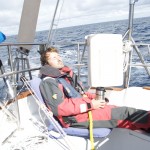
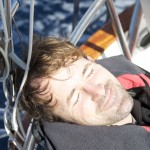
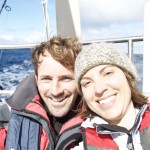
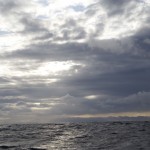
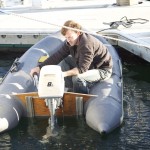
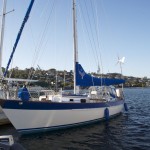
February 23rd, 2010 at 1:31 pm
Congrats on your first solo leg! Glad all is well.
February 23rd, 2010 at 1:46 pm
Congrats you two! Off on your own!! Very exciting…and remember, rest is just as important when sailing as food or water – bad decisions are made when a crew is fatigued so get those zzzzzz’s when you can! Safe travels – we’re following closely! xo
February 23rd, 2010 at 2:02 pm
FYI: Tom here, here’s a thought. I operated off a carrier in a different life time. We and the adversaries used to play war games. See and be seen, hide and seek, hit and run or see if you can find me type games. You possibly encountered a naval ship trying to see how close he could get to the carrier, maybe even trying to use you as a radar shadow. By identifying his pos, U gave him away. He would run black and no-radar, just to see if the carrier and CIC was paying attention.
February 23rd, 2010 at 4:49 pm
looking forward to your additional posts. feel like i should contribute to your journey as i am entertained and informed by your entries. linking you to all my chicago sailing friends
February 23rd, 2010 at 7:09 pm
Instead of saying you couldn’t heave to you can say that you successfully “forereached” 😀
February 23rd, 2010 at 7:11 pm
Curious what the logistics are for crossing the border to Mexico on boat? How long can you stay?
February 23rd, 2010 at 7:52 pm
1. we must enter at a designated port of entry: ensenada is just across the border, the next is cabo san lucas (so we will do ensenada, so that we are legally permitted to stop in the places between here and ensenada).
2. officially, we must fly the orange “q” flag–quarantine flag–in each new country we enter, until we are officially checked in. Though I get the feeling that mexico isn’t as strict as others.
3. we must go to whatever the official check-in office is, and provide:
a. passports for each crewmember
b. official boat paperwork (either the uscg boat registration, or the dmv state registration)
c. a crewlist, listing everyone on the boat
4. one must purchase a TIP, or “temporary import permit”; this is specific to mexico. As it happens, we already have one from when the boat was originally in mexico (when we bought it).
5. one must have mexican insurance, liability that is. This may only be necessary if you stay in a marina–not sure on this count yet.
6. if you carry a single fishing hook on the boat, you need to buy a fishing license
Not sure how long you can stay; I’ve never seen that mentioned anywhere, so it may be indefinitely. I know in french polynesia it is limited to 90 days, but mexico is decidedly not french polynesia.
February 23rd, 2010 at 7:53 pm
I thank you for that, livia!
February 24th, 2010 at 2:27 am
Always keep in mind when dealing with things that are bigger than you, whether military or commercial … You are small. You are invisible. Even if they happen to have radar or other things turned on (which they often will not), those systems are fallible, and a lot of the time nobody is paying attention anyway.
Meanwhile, don’t be so hard on yourself for being unable to heave-to. Some boats just won’t. And I have a scar on my scalp from an incident with the boom when a skipper thought he could heave-to in a boat that didn’t have a keel that would cooperate with that action.
February 24th, 2010 at 9:29 am
What a fantastic trip! 20 knots W-NW! I was a little envious on Sunday, as it was so breezy on the beach in Santa Monica. We had a great time with you all. Bon Voyage!
February 24th, 2010 at 12:05 pm
Matt & Karen
I’m really enjoying following your adventure. It looks like you are right across the bay from the North Island Naval Air Station where I did some flying during my Navy days.
February 25th, 2010 at 9:42 am
Maybe Warship 88 was on the brink of a surprise attach and you missed utter destruction by mere moments! Or maybe they were asleep at the radar screen… Best of luck you two!
February 28th, 2010 at 9:39 am
Matt,
I beg your pardon for just noticing this now, but I saw in this post that you referred to Syzygy as “her.” Do you imagine your boat to be female? Does Karen? Not that it matters, I’m just curious. Thanks Cuz.
February 28th, 2010 at 1:18 pm
yup that’s right! All boats are female. Not sure why, the reason is lost to history I imagine, but there are no male boats out there, all female!
March 5th, 2010 at 10:40 am
Great to hear that the adventure is underway. Regarding heaving to: i’ve been able to do this with my Valiant; dumb question perhaps: do you backwind the jib when you heave to? This is critical for most boats; back wind the jib and then trim the main just enough to keep the bow from blowing off completly and boat should slowly forereach at about 60 deg to the waves/wind….